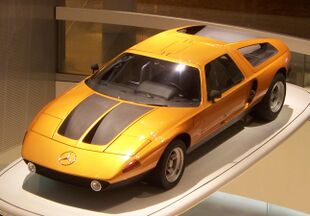Engineering:Mercedes-Benz C111
| Mercedes-Benz C111/II | |
|---|---|
 Mercedes-Benz C111/II at the Mercedes-Benz Museum | |
| Overview | |
| Manufacturer | Daimler-Benz |
| Production | 1970 (16 cars produced) |
| Assembly | Untertürkheim |
| Designer | Bruno Sacco |
| Body and chassis | |
| Class | Sports car |
| Body style | 2-door berlinetta |
| Layout | Longitudinal, Rear mid-engine, rear-wheel drive |
| Doors | Gullwing doors |
| Powertrain | |
| Power output | |
| Transmission | 5-speed manual |
| Dimensions | |
| Wheelbase | 2,620 mm (103 in) |
| Length | 4,440 mm (175 in) |
| Width | 1,800 mm (71 in) |
| Height | 1,120 mm (44 in) |
| Chronology | |
| Predecessor | Mercedes-Benz SL-X |
| Successor | Mercedes-Benz CW311 Mercedes-Benz C112 |

The Mercedes-Benz C111 was a series of experimental automobiles produced by Daimler-Benz in the 1960s and 1970s. The company was experimenting with new engine technologies, including Wankel engines, diesel engines, and turbochargers, and used the basic C111 platform as a testbed. Other experimental features included multi-link rear suspension, gull-wing doors and a luxurious interior with leather trim and air conditioning.
History
The first version of the C111 was completed in 1969, and presented at the 1969 IAA in Frankfurt. The car used a fiberglass body shell and with a mid-mounted three-rotor direct fuel injected Wankel engine (code named M950F). The next C111 appeared in 1970; it was shown at the 1970 Geneva International Motor Show. It used a four-rotor engine producing 260 kW (349 hp).[1] The car reportedly could reach a speed of 300 km/h (186 mph).[5]
The company decided not to adopt the Wankel engine and turned to diesel experiments for the second and third C111s. The C111-IID's engine was a Mercedes-Benz OM 617, and produced 140 kW (188 hp) at 4200 min−1. It was based on the Mercedes-Benz 85 kW variant of the OM 617 used in the Mercedes-Benz W 116 S-Class, but had a different turbocharger without a wastegate, which allowed an increased pressure ratio of 3.3. Daimler-Benz also added an intercooler that significantly improved the engine's thermal efficiency.[2]
The C 111 III prototype that was completed in 1978, had a more aerodynamic bodywork that gave it an air drag coefficient of 0.195. It had a modified 3-litre version of the Mercedes-Benz OM 617 five-cylinder Diesel, now producing 170 kW (228 hp), and a BMEP of 1.68 MPa, resulting in a maximum torque of 401 N·m at 3600 min−1. It enabled the C 111 III to reach a top speed of 338 km/h (210 mph) at the Nardò Ring in 1978, and also to average a 16 l/100 km fuel consumption at an average speed of 325 km/h.[3] The engine was fitted with an M-type inline injection pump of Bosch's PE series with a maxium injection pressure of 40 MPa.[6]
A later 4.5 L twin KKK-turbocharged V8 version that produced 368 kW (493 hp; 500 PS) at 6000/min[4] set another record, with an average lap-speed of 403.78 km/h (250.958 mph). This was achieved by Hans Liebold in 1 minute, 56.67 seconds on May 5, 1979.[7]
Total production was 16 cars: 13 first and second generation Wankel engined cars, two diesel engined third generation cars used in the Nardò record attempt, and a single V8 engined fourth generation car.[8]
Mercedes-Benz introduced the C112 at the Frankfurt Motor Show in 1991 as a proposed production sports car. The car used a mid-mounted 6.0 L V12 engine. After accepting 700 deposits, the company decided not to proceed with production.
References
Notes
- ↑ 1.0 1.1 1.2 Cite error: Invalid
<ref>tag; no text was provided for refs namedBensinger 1973 p. 143 - ↑ 2.0 2.1 Cite error: Invalid
<ref>tag; no text was provided for refs namedZinner 1980 p. 294 - ↑ 3.0 3.1 Reif, Konrad (2012-02-23) (in de). Klassische Diesel-Einspritzsysteme. Wiesbaden: Springer. p. 51. ISBN 978-3-8348-8664-4.
- ↑ 4.0 4.1 Cite error: Invalid
<ref>tag; no text was provided for refs namedAndreas Of-Allinger 2020 j317 - ↑ "Mercedes-Benz C 111.". https://www.mercedes-benz.com/en/classic/history/c-111/.
- ↑ Reif, Konrad (2012-02-23) (in de). Klassische Diesel-Einspritzsysteme. Wiesbaden: Springer. p. 52. ISBN 978-3-8348-8664-4.
- ↑ "Storia - Nardò Technical Center" (in it-IT). https://www.porscheengineering.com/nardo/it/thecompany/history/. "Con un motore biturbo V8 da 4,82 litri e una potenza di 373 kW (500 CV) a 6.200 giri/min, la Mercedes-Benz C111-IV raggiunge la velocità di 404 km/h. Con questa vettura l'ingegnere capo Hans Liebold percorse il "giro lanciato" sul circuito di Nardò in 1:57 min."
- ↑ "1970 Mercedes-Benz C111-II - Jay Leno's Garage". https://www.youtube.com/watch?v=jk4H1eV9JuY.
Bibliography
- Frère, Paul; Weitmann, Julius (1981). Mercedes-Benz C111: Experimental Cars. Lausanne: Edita. ISBN 2880010977.
- Kalbhenn, Wolfgang; Heidbrink, Gerhard; Hack, Joachim (2021) (in de). Mercedes-Benz C111: Fackelträger, Traumsportwagen und Rekordjäger. Stuttgart: Motorbuch Verlag. ISBN 9783613041370.
External links
- Mercedes-Benz C 111
- eMercedesBenz Feature: A Look Back At The Mercedes-Benz C 111 Research Vehicle July 31, 2008
- Some information (in french) and pictures of all C111 versions
 |




